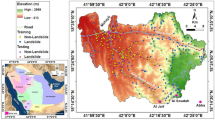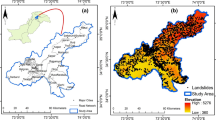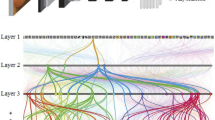Abstract
Landslides in mountain settlements are among the most widespread and dangerous geohazards. In this study, we aimed to assess landslide susceptibility using Wenchuan, southwest China, as a case. For this purpose, we constructed an optimization method that combines a convolutional neural network with the machine learning algorithm of support vector machines, quadratic discriminant analysis, Bayesian optimized gradient boosting tree, and Bayesian optimized random forest. The model inputs were 13,886 historical seismic-induced landslide events interpreted from remote sensing imagery and ten evaluation features: elevation, slope angle, slope aspect, plan curvature, profile curvature, distance to roads, distance to rivers, distance to faults, land use pattern, and soil texture. The output was the probability of landslide occurrence for each prediction unit. Finally, we evaluated the assessed outcomes using both the receiver operating characteristic curve and 1074 latest recorded landslide dataset (2013–2020). The calculations showed that the overall susceptibility values to landslides in the high–very high interval produced by the hybrid convolutional neural networks was 9.95%–16.91%, which is close to the actual landslide susceptibility of the region. The receiver operating characteristic curve and statistical analysis of the latest landslide event outcomes demonstrated that the hybrid Bayesian optimized gradient boosting tree model had a higher classification accuracy than the other classifiers presented in this study. The research findings are available to local governments and disaster management authorities in guiding disaster prevention, mitigation policy formulation, and land use and provide reference value for evaluating landslide susceptibility in other mountainous areas.











Similar content being viewed by others
Abbreviations
- AUC:
-
Area under the receiver operating characteristic curve
- BO_GBT:
-
Bayesian optimized gradient boosting tree
- BO_RF:
-
Bayesian optimized random forest
- CNN:
-
Convolutional neural network
- CSLC:
-
Classic supervised learning classifiers
- DF:
-
Distance to faults
- DRI:
-
Distance to rivers
- DRO:
-
Distance to roads
- ELE:
-
Elevation
- LCF:
-
Landslide conditioning factors
- LSM:
-
Landslide susceptibility mapping
- LSV:
-
Landslide susceptibility value
- LUP:
-
Land use pattern
- ML:
-
Machine learning
- PLC:
-
Plan curvature
- PRC:
-
Profile curvature
- QDA:
-
Quadratic discriminant analysis
- ROC:
-
Receiver operating characteristic curve
- SAN:
-
Slope angle
- SLA:
-
Slope aspect
- ST:
-
Soil texture
- SVM:
-
Support vector machines
References
Aditian A, Kubota T, Shinohara Y (2018) Comparison of GIS-based landslide susceptibility models using frequency ratio, logistic regression, and artificial neural network in a tertiary region of Ambon, Indonesia. Geomorphology 318:101–111. https://doi.org/10.1016/j.geomorph.2018.06.006
Akobeng Anthony K (2009) Understanding diagnostic tests 3: receiver operating characteristic curves. Acta Pdiatrica 96(5):644–647. https://doi.org/10.1111/j.1651-2227.2006.00178.x
Al-Akhras M, Alawairdhi M, Alkoudari A, Atawneh S (2020) Using machine learning to build a classification model for IoT Networks to detect attack signatures. Int J Comput Netw Commun (IJCNC) 12:99–116. https://doi.org/10.5121/ijcnc.2020.12607
Albawi S, Mohammed TA, Al-Zawi S (2017) Understanding of a convolutional neural network. In: International conference on engineering and technology (ICET) pp 1–6
Alzubi J, Nayyar A, Kumar A (2018) Machine learning from theory to algorithms: an overview. J Phys Conf Ser. https://doi.org/10.1088/1742-6596/1142/1/012012
Beguería S (2006) Validation and evaluation of predictive models in hazard assessment and risk management. Nat Hazards 37(3):315–329. https://doi.org/10.1007/s11069-005-5182-6
Bera S, Guru B, Oommen T (2020) Indicator-based approach for assigning physical vulnerability of the houses to landslide hazard in the Himalayan region of India. Int J Disaster Risk Reduct 50:101891. https://doi.org/10.1016/j.ijdrr.2020.101891
Brabb EE (1984) Minimum landslide damage in the United States, 1973–1983. U.S. Geological Survey Open-File Report 84–486, 5p
Breiman L (2001) Random forests. Mach Learn 45(1):5–32
Bui DT, Tsangaratos P, Nguyen VT, Liem NV, Trinh PT (2020) Comparing the prediction performance of a deep learning neural network model with conventional machine learning models in landslide susceptibility assessment. Catena 188:104426. https://doi.org/10.1016/j.catena.2019.104426
Chen W, Li Y (2020) GIS-based evaluation of landslide susceptibility using hybrid computational intelligence models. Catena 195:104777. https://doi.org/10.1016/j.catena.2020.104777
Chen T, Niu RQ, Du B, Wang Y (2015) Landslide spatial susceptibility mapping by using GIS and remote sensing techniques: a case study in Zigui County, the Three Georges reservoir, China. Environ Earth Sci 73(9):5571–5583. https://doi.org/10.1007/s12665-014-3811-7
Chen W, Pourghasemi HR, Panahi M, Kornejady A, Wang JL, Xie XS, Cao SB (2017) Spatial prediction of landslide susceptibility using an adaptive neuro-fuzzy inference system combined with frequency ratio, generalized additive model, and support vector machine techniques. Geomorphology 297:69–85. https://doi.org/10.1016/j.geomorph.2017.09.007
Chen W, Zhang S, Li R, Shahabi H (2018) Performance evaluation of the GIS-based data mining techniques of best-first decision tree, random forest, and naïve bayes tree for landslide susceptibility modeling. Sci Total Environ 644:1006–1018. https://doi.org/10.1016/j.scitotenv.2018.06.389
Chen Y, Ming D, Ling X, Lv X, Zhou C (2021) Landslide susceptibility mapping using feature fusion-based CPCNN-ML in Lantau Island, Hong Kong. IEEE J Sel Top Appl Earth Obs Remote Sens 14:3625–3639. https://doi.org/10.1109/JSTARS.2021.3066378
Chigira M, Wu X, Inokuchi T, Wang GH (2010) Landslides induced by the 2008 Wenchuan earthquake, Sichuan, China. Geomorphology 118(3–4):225–238. https://doi.org/10.1016/j.geomorph.2010.01.003
Choi KY, Cheung RWM (2013) Landslide disaster prevention and mitigation through works in Hong Kong. J Rock Mech Geotech Eng 5(5):354–365. https://doi.org/10.1061/CNKI:SUN:JRMG.0.2013-05-005
Chua LO, Roska T (1993) The CNN paradigm. IEEE Trans Circuits Syst I-Fundam Theor Appl 40(3):147–156. https://doi.org/10.1109/81.222795
Cutler DR, Edwards TC Jr, Beard KH, Cutler A, Hess KT, Gibson J, Lawler JJ (2007) Random forests for classification in ecology. Ecology 88:2783–2792. https://doi.org/10.1890/07-0539.1
Dao VD, Jaafari A, Bayat M, Mafi-Gholami D, Qi CC, Moayedi H, Phong TV, Ly HB, Le TT, Trinh PT, Luu C, Quoc NK, Thanh BN, Pham BT (2020) A spatially explicit deep learning neural network model for the prediction of landslide susceptibility. Catena 188:104451. https://doi.org/10.1016/j.catena.2019.104451
Ding MT, Heiser M, Hübl J, Fuchs S (2016) Regional vulnerability assessment for debris flows in China—a CWS approach. Landslides 13:537–550. https://doi.org/10.1007/s10346-015-0578-1
Dou J, Dieu TB, Ali PY, Jia K, Xuan S, Inge R, Xia H, Zhu ZF (2015) Optimization of causative factors for landslide susceptibility evaluation using remote sensing and GIS data in parts of Niigata, Japan. PLOS ONE 10(7):e0133262. https://doi.org/10.1371/journal.pone.0133262
Dou J, Yunus AP, Bui DT, Merghadi A, Sahana M, Zhu ZF, Chen CW, Khosravi K, Yang Y, Pham BT (2019) Assessment of advanced random forest and decision tree algorithms for modeling rainfall-induced landslide susceptibility in the Izu-Oshima Volcanic Island, Japan. Sci Total Environ 662:332–346. https://doi.org/10.1016/j.scitotenv.2019.01.221
Dressler OJ, Howes PD, Jaebum C, Demello AJ (2018) Reinforcement learning for dynamic microfluidic control. ACS Omega 3(8):10084–10091. https://doi.org/10.1021/acsomega.8b01485
Fang Z, Wang Y, Ling P, Hong H (2020a) Integration of convolutional neural network and conventional machine learning classifiers for landslide susceptibility mapping. Comput Geosci 139:104470. https://doi.org/10.1016/j.cageo.2020.104470
Fang Z, Wang Y, Peng L, Hong H (2020b) A comparative study of heterogeneous ensemble-learning techniques for landslide susceptibility mapping. Int J Geogr Inf Sci. https://doi.org/10.1080/13658816.2020.1808897
Fawcett T (2006) An introduction to roc analysis. Pattern Recognit Lett 27(8):861–874
Friedman JH (2002) Stochastic gradient boosting. Comput Stat Data Anal 38(4):367–378
Gao ZM, Ding MT, Huang T, Hu XW (2021) Geohazard vulnerability assessment in Qiaojia seismic zones, SW China. Int J Disaster Risk Reduct 52:101928. https://doi.org/10.1016/j.ijdrr.2020.101928
Gong Y, Xiao Z, Tan X, Sui H, Li D (2019) Context-aware convolutional neural network for object detection in vhr remote sensing imagery. IEEE Trans Geosci Remote Sens 99:1–11. https://doi.org/10.1109/TGRS.2019.2930246
Guzzetti F, Reichenbach P, Cardinali M, Galli M, Ardizzone F (2005) Landslide hazard assessment in the Staffora basin, northern Italian Apennines. Geomorphology 72:272–299
Guzzetti F (2006) Landslide hazard and risk assessment. transportation research board special report
Hinton GE, Osindero S, Teh YW (2006) A fast learning algorithm for deep belief nets. Neural comput 18(7):527–1554. https://doi.org/10.1162/neco.2006.18.7.1527
Hong HY, Pourghasemi HR, Pourtaghi ZS (2016) Landslide susceptibility assessment in Lianhua County (China): a comparison between a random forest data mining technique and bivariate and multivariate statistical models. Geomorphology 259:105–118. https://doi.org/10.1016/j.geomorph.2016.02.012
Hungr O, Leroueil S, Picarelli L (2014) The varnes classification of landslide types, an update. Landslides 11(2):167–194. https://doi.org/10.1007/s10346-013-0436-y
Klimeš J, Müllerová H, Woitsch J, Bíl M, Křížová B (2020) Century-long history of rural community landslide risk reduction. Int J Disaster Risk Reduct 51:101756. https://doi.org/10.1016/j.ijdrr.2020.101756
Kuradusenge M, Kumaran S, Zennaro M (2020) Rainfall-Induced landslide prediction using machine learning models: the case of Ngororero District, Rwanda. Int J Environ Res Pub Health 17(11):4147. https://doi.org/10.3390/ijerph17114147
Labiad B, Berrado A, Benabbou L (2016) Machine learning techniques for short term stock movements classification for Moroccan stock exchange. In: International conference on intelligent systems: theories & applications IEEE
Lee MJ, Song WK, Sun WJ, Won JS, Park I, Lee S (2014) Spatial and temporal change in landslide hazard by future climate change scenarios using probabilistic-based frequency ratio model. Geocarto Int 29(6):639–662. https://doi.org/10.1080/10106049.2013.826739
Lee SM, Kim JC, Jung HS, Lee MJ, Lee S (2017) Spatial prediction of flood susceptibility using random-forest and boosted-tree models in Seoul metropolitan city, Korea. Geomat Nat Haz Risk 8(2):1185–1203. https://doi.org/10.1080/19475705.2017.1308971
Lee JH, Sameen MI, Pradhan B, Park HJ (2018) Modeling landslide susceptibility in data-scarce environments using optimized data mining and statistical methods. Geomorphology 303:284–298. https://doi.org/10.1016/j.geomorph.2017.12.007
Lin CW, Liu SH, Lee SY, Liu CC (2006) Impacts of the Chi-Chi earthquake on subsequent rainfall-induced landslides in central Taiwan. Eng Geol 86(2–3):87–101. https://doi.org/10.1016/j.enggeo.2006.02.010
Mandal K, Saha S, Mandal S (2021) Applying deep learning and benchmark machine learning algorithms for landslide susceptibility modelling in Rorachu river basin of Sikkim Himalaya India. Geosci Front 12:101203. https://doi.org/10.1016/j.gsf.2021.101203
Merghadi A, Yunus AP, Dou J, Whiteley J, Pham BT, Bui TD, Avtar R, Abderrahmanea B (2020) Machine learning methods for landslide susceptibility studies: a comparative overview of algorithm performance. Earth Sci Rev 207:103225. https://doi.org/10.1016/j.earscirev.2020.103225
Mind’Je R, Li L, Amanambu A, Nahayo L, Mindje M (2019) Flood susceptibility modeling and hazard perception in Rwanda. Int J Disaster Risk Reduct 38:101211. https://doi.org/10.1016/j.ijdrr.2019.101211
Nadim F, Kjekstad O, Peduzzi P, Herold C, Jaedicke C (2006) Global landslide and avalanche hotspots. Landslides 3(2):159–173. https://doi.org/10.1007/s10346-006-0036-1
Nadim F, Lacasse S (2008) Strategies for mitigation of risk associated with landslides. Landslides-Disaster Risk Reduction
Naghibi SA, Dashtpagerdi MM (2017) Evaluation of four supervised learning methods for groundwater spring potential mapping in Khalkhal region (Iran) using GIS-based features. Hydrogeol J 25(1):169–189. https://doi.org/10.1007/s10040-016-1466-z
Nahayo L, Ndayisaba F, Karamage F, Nsengiyumva JB, Kalisa E, Mind’je R, Christophe M, Li LH (2019) Estimating landslides vulnerability in Rwanda using analytic hierarchy process and geographic information system. Integr Environ Assess Manag 15(3):364–373. https://doi.org/10.1002/ieam.4132
Neamat S, Karimi H (2020) A systematic review of GIS-based landslide hazard mapping on determinant factors from international databases. In: International conference on advanced science and engineering (ICOASE). IEEE pp 180–183
Nguyen TP, Choi S, Park SJ, Park SH, Yoon JH (2021) Inspecting method for defective casting products with convolutional neural network (CNN). Int J Precis Eng Manuf-Green Technol 8(2):583–594. https://doi.org/10.1007/s40684-020-00197-4
Niu XX, Suen CY (2012) A novel hybrid CNN–SVM classifier for recognizing handwritten digits. Pattern Recogn 45(4):1318–1325. https://doi.org/10.1016/j.patcog.2011.09.021
Orhan O, Bilgilioglu SS, Kaya Z, Ozcan AK, Bilgilioglu H (2020) Assessing and mapping landslide susceptibility using different machine learning methods. Geocarto Int. https://doi.org/10.1080/10106049.2020.1837258
Pan G, Tang DL (2010) Damage information derived from multi-sensor data of the Wenchuan earthquake of May 2008. Int J Remote Sens 31(13):3509–3519. https://doi.org/10.1080/01431161003730865
Patra P, Devi R (2015) Assessment, prevention and mitigation of landslide hazard in the Lesser Himalaya of Himachal Pradesh. Environ Socio-Econ Stud 3(3):1–11
Pham BT, Tien Bui D, Prakash I, Dholakia MB (2017) Hybrid integration of multilayer perceptron neural networks and machine learning ensembles for landslide susceptibility assessment at Himalayan area (India) using GIS. Catena 149:52–63. https://doi.org/10.1016/j.catena.2016.09.007
Pourghasemi HR, Kerle N (2016) Random forests and evidential belief function-based landslide susceptibility assessment in Western Mazandaran Province. Iran Environ Earth Sci 75(3):1–17. https://doi.org/10.1007/s12665-015-4950-1
Riedel I, Guéguen P, Mura DM, Pathier E, Leduc T, Chanussot J (2015) Seismic vulnerability assessment of urban environments in moderate-to-low seismic hazard regions using association rule learning and support vector machine methods. Nat Hazards 76(2):1111–1141. https://doi.org/10.1007/s11069-014-1538-0
Rong G, Si A, Li K, Su Y, Li T (2020) Rainfall induced landslide susceptibility mapping based on bayesian optimized random forest and gradient boosting decision tree models—a case study of Shuicheng County, China. Water 12(11):3066. https://doi.org/10.3390/w12113066
Sahana M, Rehman S, Sajjad H, Hong HY (2020) Exploring effectiveness of frequency ratio and support vector machine models in storm surge flood susceptibility assessment: A study of Sundarban Biosphere Reserve, India. Catena 189:104450. https://doi.org/10.1016/j.catena.2019.104450
Sameen MI, Pradhan B, Lee S (2020) Application of convolutional neural networks featuring Bayesian optimization for landslide susceptibility assessment. Catena 186:104249
Shang XY, Li XB, Morales-Esteban A, Asencio-Cortés G, Wang ZW (2018) Data field-based K-means clustering for spatio-temporal seismicity analysis and hazard assessment. Remote Sens 10(3):461. https://doi.org/10.3390/rs10030461
Singh P, Kaur A, Gupta KA (2020) Hazard-risk and vulnerability assessment for the National Zoological Park at New Delhi, India. Int J Disaster Risk Reduct 50:101819. https://doi.org/10.1016/j.ijdrr.2020.101819
Song YX, Niu RQ, Xu SL, Ye RQ, Ling P, Guo T, Li SY, Chen T (2018) Landslide susceptibility mapping based on weighted gradient boosting decision tree in Wanzhou section of the Three Gorges reservoir area (China). ISPRS Int J Geo-Inf 8(1):4. https://doi.org/10.3390/ijgi8010004
Tang C, Zhu J, Li WL, Liang JT (2009) Rainfall-triggered debris flows following the Wenchuan earthquake. Bull Eng Geol Env 68(2):187–194. https://doi.org/10.1007/s10064-009-0201-6
Thiery Y, Terrier M, Colas B, Fressard M, Maquaire O, Grandjean G, Gourdier S (2020) Improvement of landslide hazard assessments for regulatory zoning in France: STATE–OF–THE-ART perspectives and considerations. I J Disaster Risk Reduct 47:101562. https://doi.org/10.1016/j.ijdrr.2020.101562
Vakhshoori V, Zare M (2018) Is the ROC curve a reliable tool to compare the validity of landslide susceptibility maps? Geomat Nat Haz Risk 9(1):249–266. https://doi.org/10.1080/19475705.2018.1424043
Vinayakumar R, Soman KP, Poornachandran P (2017) Applying convolutional neural network for network intrusion detection. In: International conference on advances in computing communications and informatics (ICACCI)
Wang S, Chen H (2019) A novel deep learning method for the classification of power quality disturbances using deep convolutional neural network. Appl Energy 235:1126–1140. https://doi.org/10.1016/j.apenergy.2018.09.160
Wang FW, Cheng QG, Highland L, Miyajima M, Wang HB, Yan CZ (2009) Preliminary investigation of some large landslides triggered by the 2008 Wenchuan earthquake, Sichuan Province, China. Landslides 6(1):47–54. https://doi.org/10.1007/s10346-009-0141-z
Wang HJ, Zhang LM, Luo HY, He J, Cheung RWM (2021) AI-powered landslide susceptibility assessment in Hong Kong. Eng Geol 288:106103. https://doi.org/10.1016/j.enggeo.2021.106103
Wu Z, Jiang S, Zhou X, Wang Y, Liu Q (2020) Application of image retrieval based on convolutional neural networks and Hu invariant moment algorithm in computer telecommunications. Comput Commun 150:729–738. https://doi.org/10.1016/j.comcom.2019.11.053
Xie FD, Gao QS, Cui J, Zhao FX (2021) Hyperspectral image classification based on superpixel pooling convolutional neural network with transfer learning. Remote Sens 13(5):930. https://doi.org/10.3390/rs13050930
Yalcin A (2008) GIS-based landslide susceptibility mapping using analytical hierarchy process and bivariate statistics in Ardesen (Turkey): comparisons of results and confirmations. Catena 72:1–12. https://doi.org/10.1016/j.catena.2007.01.003
Yang J, Song C, Yang Y, Xu C, Guo F, Xie L (2018) New method for landslide susceptibility mapping supported by spatial logistic regression and geodetector: a case study of duwen highway basin, Sichuan Province, China. Geomorphology 324:62–71. https://doi.org/10.1016/j.geomorph.2018.09.019
Yi YN, Zhang Z, Zhang W, Jia H, Zhang J (2020) Landslide susceptibility mapping using multiscale sampling strategy and convolutional neural network: a case study in Jiuzhaigou region. Catena 195:104851. https://doi.org/10.1016/j.catena.2020.104851
Yin YP (2008) Researches on the geo-hazards triggered by Wenchuan earthquake Sichuan. J Eng Geology 16(4):433–444. https://doi.org/10.1016/S1872-5791(08)60056-1 ((In Chinese))
Yin YP, Wang FW, Sun P (2009) Landslide hazards triggered by the 2008 Wenchuan earthquake, Sichuan, China. Landslides 6(2):139–152. https://doi.org/10.1007/s10346-009-0148-5
Youssef AM, Pourghasemi HR (2021) Landslide susceptibility mapping using machine learning algorithms and comparison of their performance at Abha Basin, Asir Region. Saudi Arabia Geosci Front 12(2):639–655. https://doi.org/10.1016/j.gsf.2020.05.010
Zhang S, Zhang LM, Peng M, Zhang LL, Zhao HF, Chen HX (2012) Assessment of risks of loose landslide deposits formed by the 2008 Wenchuan earthquake. Natural Hazards and Earth Syst 12(5):1381–1392. https://doi.org/10.5194/nhess-12-1381-2012
Zhang S, Zhang LM, Chen HX, Yuan Q, Pan H (2013) Changes in runout distances of debris flows over time in the Wenchuan earthquake zone. J Mt Sci 10:281–292. https://doi.org/10.1007/s11629-012-2506-y
Zhang S, Zhang LM, Glade T (2014) Characteristics of earthquake- and rain-induced landslides near the epicenter of Wenchuan earthquake. Eng Geol 175:58–73. https://doi.org/10.1016/j.enggeo.2014.03.012
Acknowledgements
The authors appreciate the support from Peng Du on the landslide data and Jintao Huang on the algorithm discussion and acknowledge the insightful comments of the editor and anonymous referees that were very helpful for an improvement in an earlier version of the manuscript.
Funding
This research was supported by the National Natural Science Foundation of China under Grant (No. 41871174) and the project of Science and Technology Department of Sichuan Province under Grant (No. 2020YFSY0013).
Author information
Authors and Affiliations
Corresponding author
Ethics declarations
Conflict of interest
The authors declare that they have no known competing financial interests or personal relationships that could have appeared to influence the work reported in this paper.
Additional information
Publisher's Note
Springer Nature remains neutral with regard to jurisdictional claims in published maps and institutional affiliations.
Rights and permissions
About this article
Cite this article
Gao, Z., Ding, M. Application of convolutional neural network fused with machine learning modeling framework for geospatial comparative analysis of landslide susceptibility. Nat Hazards 113, 833–858 (2022). https://doi.org/10.1007/s11069-022-05326-7
Received:
Accepted:
Published:
Issue Date:
DOI: https://doi.org/10.1007/s11069-022-05326-7




